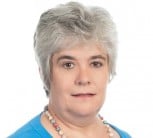Images and video clips that looked like scenes from the disaster movie Twister were all over social media a few weeks ago when unexpected tornadoes hit the Gauteng province.
This weather phenomenon surprised not only motorists on their way home from work, but also experts in the field. 'It was very unusual weather,' says meteorologist Dr Liesl Dyson from the University of Pretoria's Department of Geography, Geoinformatics and Meteorology.
Tornadoes are not common in South Africa, but it is even more unusual to see them when the surface temperatures are relatively cool. Tornadoes are usually formed during a thunderstorm, and July is not the usual time for thunderstorms in Gauteng. As was proved recently, however, they do occur in winter from time to time.
There was little wind at surface level in Gauteng, but about 4 km above, winds were blowing at a speed of up to 140 km/h. When this happens, it results in a wind shear or a horizontal rotating column of air. When this column meets with a strong updraft that changes its direction, the column can rotate to become vertical. The result is the characteristic funnel that forms between the thunder clouds and the surface of the earth and leaves a trail of destruction behind it as it travels along, rotating at great speed.
'There are ways to predict tornadoes, but in South Africa weather experts are not really on the lookout for them as they are not as common as they are in America. The Weather Service did, however, warn people that severe thunderstorms could be expected that Tuesday,' says Dr Dyson.
The whole country was recently affected by dangerous weather, including snow on the Drakensberg mountains, heavy rain in KwaZulu-Natal, and strong winds and huge waves along the coastal areas.
Dr Dyson says there were many meteorological elements working together to create the perfect conditions for the formation of the tornadoes. It was indeed the perfect storm.
Tornadoes can cause a lot of damage to lives and property and are measured according to the Fujita-Pearson Tornado Scale, a diagnostic scale that measures tornadoes in terms of the damage they cause rather than the strength of the wind or other factors.
Although there was significant damage as a result of the Gauteng tornadoes, it was minor when compared to the tornadoes that occur regularly in many areas of North-America. The reason for the great number of tornadoes in America is that the moist, warm air that sweeps up from the Gulf of Mexico in the south meets with the cool, dry air that flows over the country from the north. Owing to the large inland area of North America, strong updrafts occur and huge tornadoes are therefore often formed there.
Looking at some of the videos and photos that were taken by witnesses in Gauteng, Dr Dyson regards it as something of a miracle that there were not more injuries or deaths caused by flying debris. 'Tornadoes can be very powerful and, looking at some of the footage, it is clear that people came very close to them,' she says.
In the United States, many people have tornado bunkers to protect them when a tornado hits, but in the absence of such facilities it is definitely safer to be indoors and under a table than outside with a mobile phone in one's hand, she explains.
Dr Liesl Dyson
August 8, 2016

Professor Liesl Dyson studied Meteorology at the University of Pretoria (UP), which is the only university in South Africa that offers a degree in Meteorology that complies with the World Meteorology Organisation’s training standards. Prof Dyson has been doing research at UP for 25 years, and says “the beauty of clouds inspired me to study meteorology”.
As an associate professor in Meteorology in the Department of Geography, Geoinformatics and Meteorology, research is part of what she does. The research that she and her students are involved in deals with understanding the character of severe weather phenomena, investigating the development mechanisms of these phenomena and finding ways to better predict these events. As for how her research contributes to the betterment of the world, she says that timeous warnings of severe weather could save lives and property.
Many of the postgraduate students who do research under her supervision are employed at the South African Weather Service.
“Together, we identify which weather phenomena needs further investigation, then set about improving the understanding and forecasting of these,” Prof Dyson explains. “At the moment, there is special emphasis on severe thunderstorms. We investigate thunderstorms by using radar and state-of-the-art numerical weather prediction products. However, other phenomena such as sand/dust storms and snow are also included in our research.”
Prof Dyson collaborates with the Natural Hazard Centre, which statistically analyses the hail data she generates by using numerical weather prediction data and a hail model. The result of this collaboration determines the risk of hail over South Africa.
A highlight for her was being awarded the Water Research Commission’s Knowledge Tree Innovation Award in 2019 for a project entitled ‘The impact of the predictability of continental tropical lows on hydrological modelling: Current state and future projections’. This award celebrates outstanding design, process and product development of innovative technologies. The research investigated and named a specific type of tropical weather system over southern Africa, which they called Africánes. The system is a tropical cyclone-like low-pressure system that develops over Africa and causes very heavy rainfall over the sub-continent.
Two of the master’s students working under her supervision received the prestigious Society of South African Geographers Master’s Bronze Medal, which is awarded to the best geography MSc completed by research dissertation within a given year in South Africa. Christina Liesker received the award in 2022 for her work on supercell identification using weather radar and Markus Geldenhuys in 2019 for his work on the dangerous mountain wave phenomena over the Eastern Cape.
Prof Dyson’s role model in meteorology is Dr Jan Taljaard.
“I had the privilege of working with him for a short while when I was a young forecaster at the South African Weather Bureau. I admire him so much because he was an expert in real weather. It was all about what was going on outside and he instilled in me a hunger to do the same. He authored several papers about synoptic circulation over South Africa, and even though he has long since passed away, these documents are still my go-to papers when I do my own research. I discover new insights every now and again.”
Prof Dyson hopes to play a small part in helping weather forecasters in South Africa to be enthusiastic about the weather, be excellent in their jobs and have the knowledge through training and research to issue forecasts of high quality.
Research shows that in a changing climate, severe weather events are increasing. On short time scales, weather forecasters are responsible for issuing warnings for these events. Prof Dyson’s research matters because it aims to help forecasters to issue such warnings.
She says many young people are interested in the weather because they see and experience the effect of climate change and want to get involved in helping to address arising issues. Others are simply fascinated by tropical cyclones (hurricanes) and tornadoes, and by clouds. She advises school learners that in order to study meteorology, they need to take mathematics and natural science as subjects at school.
“We use Newton’s second law and the laws of thermodynamics to model the atmosphere, and learners need the mathematical tools to do that.”
Prof Dyson loves gardening in her spare time and enjoys outdoors activities with her dogs.
 Story
Story
University of Pretoria (UP) researchers have found that the antioxidant content of certain types of tea can be likened to that found in recommended portions of fruit and vegetables.
 Infographic
Infographic
Half a cup of black tea, oolong tea or green tea contained the same amount of antioxidants with radical scavenging capabilities (RSC) as that of a 200mg vitamin C tablet.
 Story
Story
The latest issue of the University of Pretoria’s award-winning RE.SEARCH magazine is available now and reflects a shift towards both a fresher design and outlook. This edition is curated under the theme ‘Digital’, and offers a glimpse into some of the fascinating research we’re doing at UP to drive digital leadership and innovation.
Copyright © University of Pretoria 2025. All rights reserved.
Get Social With Us
Download the UP Mobile App